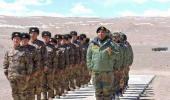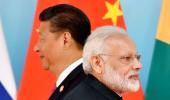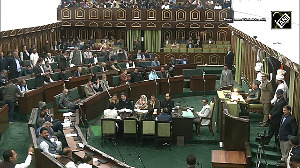Tanks and infantry combat vehicles of India and China started disengaging from both the banks of Pangong Tso as part of the disengagement process between the two countries along the Line of Actual Control.

A video shared by the Indian Army showed the pulling back of three tanks of the Chinese People's Liberation Army and one by the Indian side from south of Pangong Tso besides brief shots of a meeting between troops of the two sides.
Official sources told PTI withdrawal of tanks and other armoured elements from certain friction points is nearing completion while pulling back of troops from the North bank areas is being undertaken.
Sources said under the first phase of disengagement, the tanks of India are being moved back towards Nyoma and adjoining areas while the Chinese are taking them back beyond Sirijap and Moldo garrison.
"The movement related to disengagement of tanks and infantry combat vehicles from forward positions to rear locations started last evening itself. The disengagement from the two banks of the Pangong lake is aimed to be completed within seven days," a source told ANI.
After the first phase of disengagement is completed, the two sides would start discussing the other friction points including the Patrolling Point-17 and PP-15, they said.
To finalise the modalities, sources said the two sides had held extensive Army to Army discussions through hotlines as well as the two physical meetings in the Chushul sector on February 8 and 9.
The strategic heights on the southern bank of Pangong lake Rezang La and Rechen La, which were captured by the Indian troops in a preemptive operation in late August, are also witnessing disengagement.
Defence Minister Rajnath Singh on Thursday told parliament that Indian and China have reached an agreement for disengagement on the north and south bank of Pangong Lake and the country will not allow anyone to take an inch of its land.
While India has to move to the Dhan Singh Thapa post near Finger 3, the Chinese will be moving to the east of Finger 8.The two countries have deployed over 50,000 troops opposite each other in the eastern Ladakh area ever since the Chinese tried to change the status quo.
Sharing details of the pact to defuse the tense military face-off in eastern Ladakh that severely strained ties between the two Asian giants, Singh also assured the Rajya Sabha that India has not conceded anything in the sustained talks with China and it will not allow even an inch of its territory to be taken away by anyone.

Making a statement in the Rajya Sabha a day after China announced the disengagement process, Singh said China will pull back its troops to east of Finger 8 areas in the northern bank of Pangong lake while the Indian personnel will be based at their permanent base at Dhan Singh Thapa Post near Finger 3 in the region. Similar action will take place at the southern bank of the lake as well, he said.
In an identical statement later in the Lok Sabha, he said the disengagement process was "going on well", and that the implementation of the pact will "substantially restore" the situation to the one which existed prior to the standoff that erupted on May 5 last.
The defence minister said both sides have agreed to remove structures that had been built since April last in the North and South bank areas, and put in place a temporary moratorium on military activities including patrolling the traditional areas.
He said the two sides have agreed they should achieve complete disengagement at the "earliest" and abide fully by the bilateral agreements and protocols.
Sources in the defence and security establishment said the disengagement from the eye-ball-to-eyeball situation is the first step towards overall de-escalation and it may take several weeks to complete the entire process at all the friction points.
In the nine rounds of military talks, India had specifically insisted on withdrawal of Chinese troops from Finger 4 to Finger 8 on the North bank of Pangong Lake. The mountain spurs in the area are referred to as Fingers.
On its part, the Chinese side was insisting on withdrawal of Indian troops from several strategic peaks on the southern bank of the lake.
Around five months back, Indian troops occupied a number of strategic heights in the Mukhpari, Rechin La and Magar hill areas around the southern bank after the Chinese PLA attempted to intimidate them in the area.
Defence Minister Singh said three key principles determined India's approach in handling the situation which are "the both sides should strictly respect and observe the LAC, neither side should attempt to alter the status quo unilaterally, and all agreements and understandings between the two sides must be fully abided by in their entirety."
In his statement, Singh also gave a genesis of the standoff and said the Chinese side had mobilised a large number of troops and armaments along the LAC as well as in the depth areas, adding Indian armed forces too had made adequate and effective counter deployments to ensure that India's security interests were fully protected.
China on Wednesday said the Chinese and Indian frontline troops at the southern and northern bank of the Pangong Tso started "synchronised and organised disengagement" from February 10 in accordance with the consensus reached by both sides at the ninth round of China-India Corps Commander- Level meeting. The ninth round was held on January 24 and it lasted for around 16 hours.
Both sides had rushed a large number of battle tanks, armoured vehicles and heavy equipment to the treacherous and high-altitude areas of eastern Ladakh region after tension escalated following a deadly clash in the Galwan Valley in June last.
Twenty Indian soldiers were killed in the fierce hand-to-hand combat on June 15 in Galwan Valley, an incident that marked the most serious military conflicts between the two sides in decades.
China is yet to disclose the number of its soldiers killed and injured in the clash though it officially admitted to have suffered casualties.
According to an American intelligence report, the number of casualties on the Chinese side was 35.
With inputs from ANI and PTI











 © 2025
© 2025